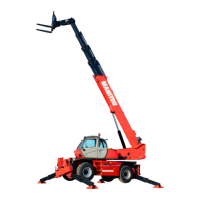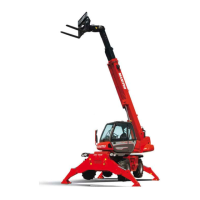1-34
it en
648665 IT-EN-PL (20/03/2014)
pl
general operating instructions
Starting up the radio remote control.
Starting up the radio remote control
consists in building a radio link between
the transmitting and the receiving unit.
For this purpose, you need to:
- power on the receiving unit respecting
the voltage limits provided in the
technical data (Vedere Capitolo: 2-
DESCRIZIONE). The POWER LED
switches on,
- insert a charged battery in the
transmitting unit (Vedere Capitolo:
2-DESCRIZIONE),
- insert the S-KEY in the transmitting unit
- press the START pushbutton in the tran
smitting unit until the POWER LED in
the receiving unit and the green LED in
the transmitting unit start blinking
slowly.
Command activation
With the radio remote control started, act
on the joysticks, pushbuttons and
switches corresponding to the command to be
performed.
The user must be properly trained about the
symbols on the transmitting unit panel, to be
aware of the matching between actuators and
movements on the machine.
Data Feedback Function.
The user receives information and/or signals
concerning the controlled machine by means
of the Data Feedback function.
During normal radio remote control operation,
pay particular attention to the indications
displayed and signalled by the display or
through the LEDs: they can be
helpful to evaluate the machine working
status.
When operating and moving the machine,
remember that the radio remote
control does not intervene autonomously
when potential hazardous situations
are displayed and signalled.
Operation with display.
If the transmitting unit has a display, it is
possible to visualize signal icons,
measurements collected from the machine
and their description.
(See chapter: 2-DESCRIPTION)
Operation with LED.
If the transmitting unit has an LED array,
particular machine conditions are signal
led if they are on.
(See chapter: 2-DESCRIPTION)
Radio link interruption.
When the radio link is incorrect or
interrupted for a certain period of time,
the passive stop function automatically
cuts in.
The green LED on the transmitting unit
switches from blinking slowly to fast
blinking.
The POWER LED on the receiving unit
switches from blinking to steady on.
Press the START pushbutton to start the
radio remote control.
Transmitting unit automatic switch off.
The transmitting unit automatically
switches off when:
istruzioni generali per il funzionamento
Avviamento del radiocomando.
L’avviamento del radiocomando consiste
nell’instaurare il collegamento
radioelettrico tra le unità trasmittente e
ricevente. Per ottenere ciò, è necessario:
- alimentare l’unità ricevente rispettando i limiti
di tensione riportati nei dati tecnici
(Vedere Capitolo: 2-DESCRIZIONE). Il LED
POWER si accende,
- inserire una batteria sicuramente carica
nell’unità trasmittente (Vedere Capitolo: 2-
DESCRIZIONE),
- inserire la S-KEY nell’unità trasmittente
- premere il pulsante START dell’unità
trasmittente fino a quando il LED POWER
nell’unità ricevente e il LED verde nell’unità
trasmittente iniziano a lampeggiare
lentamente.
Attivazione dei comandi
Con radiocomando avviato è possibile
azionare i joystick, i pulsanti e i selettori
relativi al comando che si intende
effettuare.
Per conoscere la corrispondenza tra gli
attuatori e le manovre della macchina,
l’operatore dovrà essere adeguatamente
addestrato riguardo la simbologia
presente nel pannello dell’unità
trasmittente.
Funzionalità Data Feedback.
La funzionalità Data Feedback rende
disponibili all’operatore le informazioni
e/o le segnalazioni riguardanti la
macchina che sta comandando.
Durante il normale funzionamento del
radiocomando prestare attenzione alle
indicazioni visualizzate e segnalate dal
display o dai LED: esse sono un aiuto per
valutare la situazione operativa in cui si
trova la macchina.
Nell’operare e nell’azionare la macchina,
considerare che il radiocomando non
interviene autonomamente nelle poten-
ziali situazioni di pericolo visualizzate e
segnalate.
Funzionamento con display.
Se nell’unità trasmittente è presente un
display possono essere visualizzate le
icone di segnalazione, i valori delle
misure effettuate nella macchina e le
loro descrizioni.
(Vedere Capitolo: 2-DESCRIZIONE)
Funzionamento con LED.
Se nell’unità trasmittente sono presenti
dei LED, la loro accensione segnala parti
colari condizioni della macchina.
(Vedere Capitolo: 2-DESCRIZIONE),
Interruzione del collegamento
radioelettrico.
Quando per un certo tempo il
collegamento radioelettrico risulta errato
o interrotto, interviene la funzione di
arresto passivo.
Il LED verde dell’unità trasmittente passa
dal lampeggio lento a veloce.
Il LED POWER dell’unità ricevente passa
dal lampeggio ad acceso fisso.
Per avviare il radiocomando, premere il
pulsante START.
Spegnimento automatico dell’unità
trasmittente.
Lo spegnimento automatico dell’unità
trasmittente avviene quando:
it
ogólna instrukcja obsługi
Włączanie pilota radiowego.
Włączenie pilota polega na nawiązaniu
połączenia radioelektrycznego pomiędzy
nadajnikiem a odbiornikiem. Aby to zrobić,
należy:
- włączyć zasilanie odbiornika, przestrzegając
limitów napięcia podanych w danych
technicznych (Patrz rozdział: 2 - OPIS). Dioda
LED POWER zaczyna świecić,
- włożyć naładowaną baterię do nadajnika
(Patrz rozdział: 2 - OPIS),
- włożyć S-KEY do nadajnika,
- nacisnąć przycisk START nadajnika i
przytrzymać, aż dioda LED POWER odbiornika i
zielona dioda LED nadajnika zaczną powoli
migać.
Aktywacja urządzeń sterowniczych
Za pomocą pilota można uruchomić joystick,
przyciski i przełączniki sterujące planowanym
ruchem.
Aby poznać jaki siłownik odpowiada za jaki
manewr podnośnika, operator musi zostać
odpowiednio przeszkolony w zakresie symboli
umieszczonych na panelu nadajnika.
Funkcja Data Feedback.
Funkcja Data Feedbacka umożliwia operatorowi
dostęp do informacji i/lub sygnałów
dotyczących sterowanej maszyny.
Podczas normalnej pracy pilota zwracać uwagę
na informacje wyświetlane i sygnalizowane na
wyświetlaczu lub przez diody LED: pomagają
one ocenić sytuację roboczą, w jakiej znajduje
się podnośnik.
Podczas pracy i sterowania maszyną pamiętać,
że pilot nie reaguje samodzielnie na
wyświetlane i sygnalizowane, potencjalne
sytuacje zagrożenia.
Praca z wyświetlaczem.
Jeżeli nadajnik ma wyświetlacz, mogą być na
nim wyświetlane ikony sygnalizacyjne, wartości
dokonanych w podnośniku pomiarów oraz ich
opisy.
(Patrz rozdział: 2 - OPIS)
Praca z diodami LED.
Jeżeli nadajnik ma diody LED, ich zaświecenie
sygnalizuje szczególne warunki pracy
podnośnika.
(Patrz rozdział: 2 - OPIS),
Przerwanie połączenia radioelektrycznego.
Jeżeli przez jakiś czas połączenie
radioelektryczne jest nieprawidłowe lub
przerwane, włącza się funkcja zatrzymania
biernego.
Zielona dioda LED nadajnika zaczyna migać
szybciej.
Dioda LED POWER odbiornika zaczyna świecić
światłem ciągłym.
Aby włączyć pilota, nacisnąć przycisk START.
Automatyczne wyłączanie nadajnika.
Nadajnik wyłącza się automatycznie kiedy:
648870 IT-EN-PL (04/05/2015)

